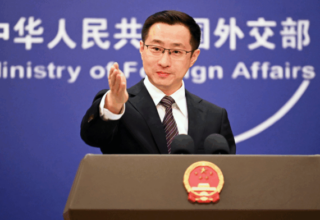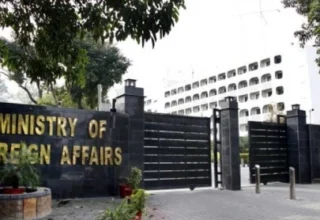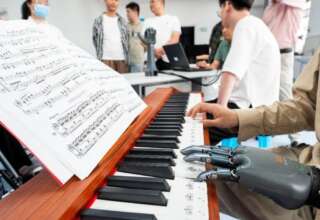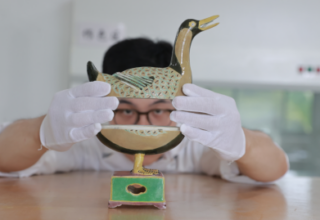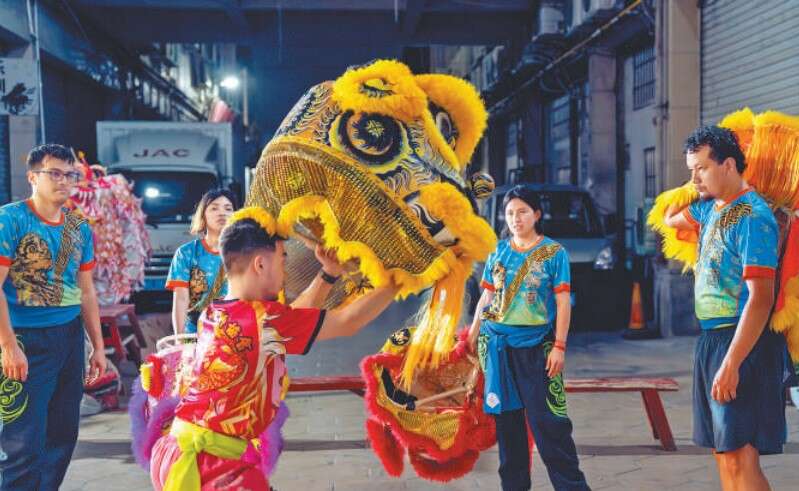
To the drum beat, a red “lion” jumped airily onto a stool, looking around, its head tilted…
After the lion dance ended, Atilio Alfredo Sarmiento Rivera, a young Peruvian, stuck his head out of the lion. He was sweating, but a smile could be seen on his face.
Alfredo and three other young Peruvians, all of whom are members of the lion dance troupe of Peru’s Sociedad Central de Beneficencia China, came to China in late October, to further improve their lion dance skills and experience the country.
On Oct. 25, Chen Xiaodan, coach of Guangzhou Sport University’s dragon and lion dances team and assistant professor of the university’s school of martial art, gave a lesson to the Peruvian dancers on the campus of the university in Guangzhou, south China’s Guangdong province.
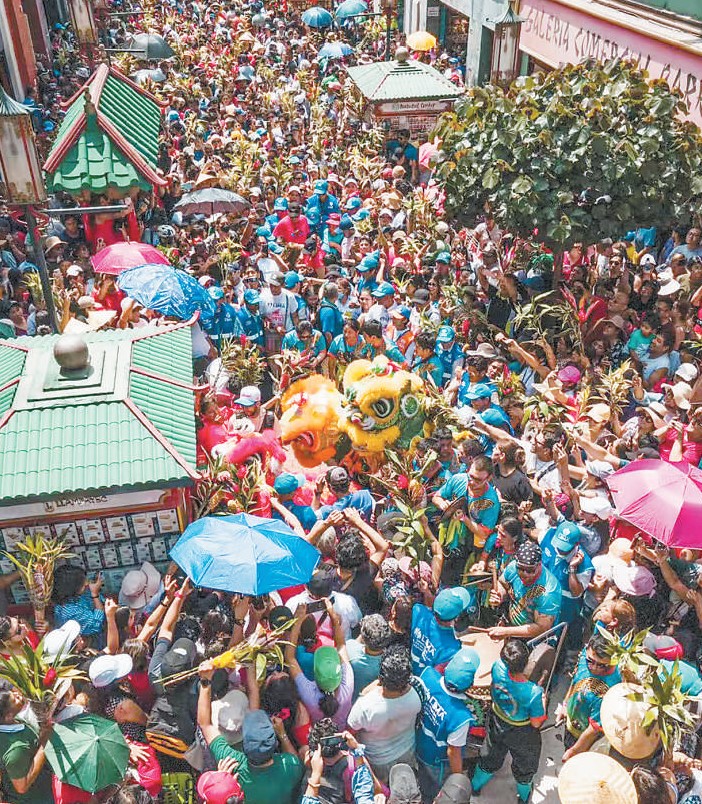
The lion dance troupe of Peru’s Sociedad Central de Beneficencia China performs lion dance in Peru. (Photo provided by the interviewee)
“How can you see your way with your head hidden in the lion’s head? The secret is to put your horizon on the same level of the lion’s jaw,” Chen told them. What he said was interpreted by his colleague Su Qiaobin.
Peru is one of the Latin American countries with the longest history of Chinese immigration and the largest Chinese communities. The fine traditional Chinese culture, represented by dragon and lion dances, has a tremendous fan base among local people and overseas Chinese. China-Peru friendship receives wide support there.
The lion dance troupe of Peru’s Sociedad Central de Beneficencia China is the largest of its kind in Peru. It has over 200 members, including both natives and Chinese Peruvians, whose age range from 9 to 55. The troupe often performs at public ceremonies and international culture festivals in Peru.
Alfredo had long looked forward to his trip to China this time. His great grandfather was a Chinese man who migrated to Peru.
“Chinese culture has a profound impact on me. I’ve been learning Chinese martial art and lion dance since a child,” he said.
Being on the land that his great grandfather always talked about, Alfredo felt an inexplicable sense of connection and belonging, which drove him to work and learn even harder during this trip.
“They are energetic and have obtained solid essential skills, but their moves are not powerful enough,” Chen commented.
The Guangzhou Federation of Returned Overseas Chinese offered these young Peruvians the opportunity to improve their moves under the guidance of Chen.
As a result, they have “unlocked” multiple challenging moves. “I never thought that I could do it. I’ll teach the new moves to other members,” Alfredo said excitedly.
Alfredo and his peers also visited a dragon and lion dances association in Xingtan township, Shunde district, Foshan, Guangdong province. Established in 2012, the association has over 80 members and has won prizes in multiple major lion dance competitions. Thanks to the innovative ideas of the association, it has went viral online and gained many followers.
The head coach of the association Mai Wangtao speaks fluent English. The Peruvian dancers were always amused by his humorous instructions.

Mai Wangtao (in red) instructs young Peruvians to perform lion dance, including Alfredo (first from left).
“We came here out of admiration,” Alfredo told People’s Daily, saying that he had seen performances by this association on social media before, which had greatly impressed him. Coming to China this time, he naturally wouldn’t miss the opportunity for learning and exchange. “We used to learn traditional routines, but we are eager to add some cooler moves!”
Mai said that with more and more young people joining in, the traditional dragon and lion dances are constantly innovating as they are inherited, incorporating new elements such as dance and acrobatics.
Mai told People’s Daily, “Traditional culture must also keep pace with the times. In order to be more attractive, it has to become more expressive, so that the lion dance culture can be spread more widely and last longer.”
Alfredo said that Mai, born in 1997, is younger than him and his three peers, yet Mai has bolder ideas and a style that aligns more with the aesthetic preferences of young people when it comes to lion dance. This made Alfredo rethink the relationship between inheritance and innovation.
“Perhaps when I return to Peru, I can also incorporate some Peruvian dance elements into lion dance,” Alfredo said.
When he was free in China, Alfredo liked wandering around. He visited the Foshan Ancestral Temple, where the exquisite architecture and ancient charm made him feel like stepping into a folk art museum. He also toured the Fengjian Watertown in Shunde, where he appreciated the rippling waters and crisscrossing ancient stone paths. He gained a lot from his stay of over 10 days in Foshan.
“China has not only modern development but also profound traditional culture. They blend perfectly into people’s daily lives, which is quite amazing,” Alfredo said. “This trip was definitely worth it!”
“Lion dance has a long history. It embodies courage, strength, and good fortune,” said Deng Zhentang, a director of Peru’s Sociedad Central de Beneficencia China.
“The lion dance not only represents the nostalgia of overseas Chinese, but also promotes friendship and unity between the Latin American and Chinese peoples,” he added.
Nowadays, lion dance troupes have been established in major cities where Chinese communities reside in Peru, and an increasing number of Peruvians have developed a liking for the vibrant Chinese lion dance.


